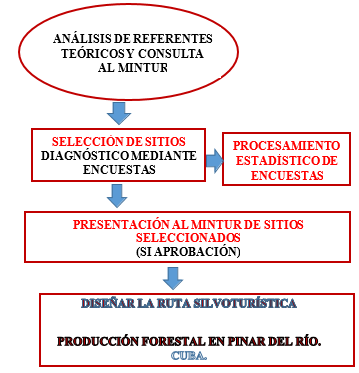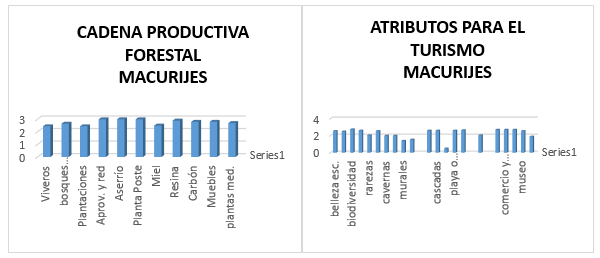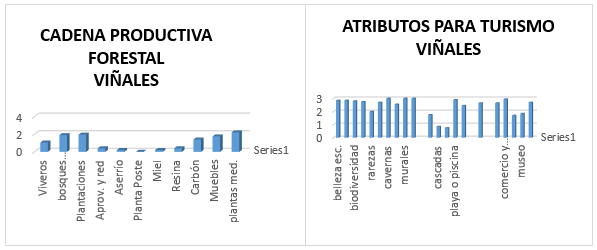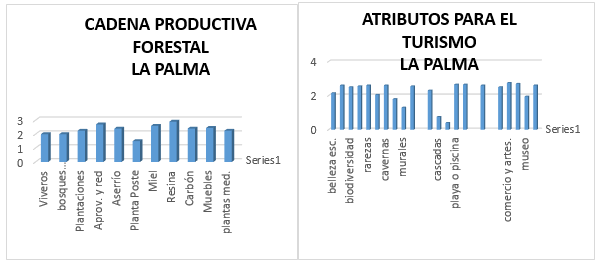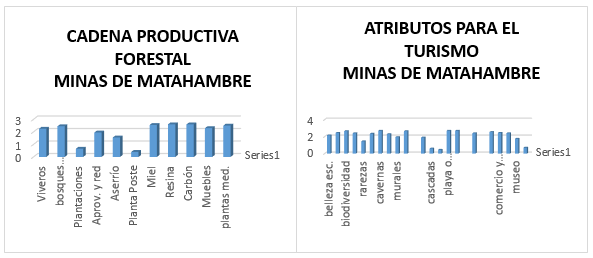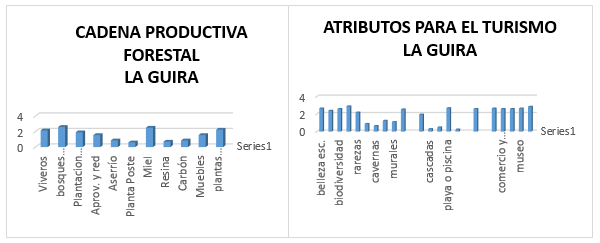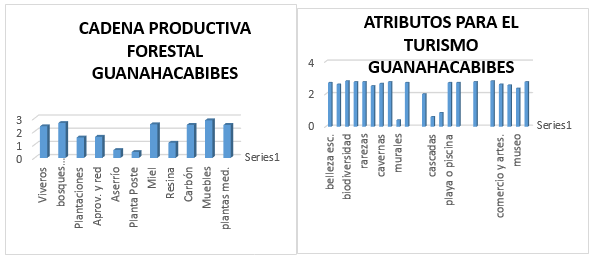My SciELO
Services on Demand
Article
Indicators
-
 Cited by SciELO
Cited by SciELO
Related links
-
 Similars in
SciELO
Similars in
SciELO
Share
Revista Cubana de Ciencias Forestales
On-line version ISSN 2310-3469
Rev cubana ciencias forestales vol.9 no.1 Pinar del Río Jan.-Apr. 2021 Epub Apr 05, 2021
Original article
Methodological-touristic proposal to highlight forest production links in Pinar del Río, Cuba
1Universidad de Pinar del Río "Hermanos Saíz Montes de Oca". Pinar del Río, Cuba.
The province of Pinar del Río has very attractive landscapes, where forests play an important role in ecosystem services of scenic beauty and others. The forestry sector is in charge of their establishment, maintenance and conservation, whether they are plantations or natural forests. The fact of promoting in these sites of tourist interest, with the presence of forests in their landscapes, particularities of forest production and the actions of agroforestry enterprises, is an interesting potential for attraction and enjoyment. The scientific problem derived was, how to contribute to the national and international promotion of the most significant sites of forest production in Pinar del Río? The objective of this research consisted in proposing methodological elements for the design of a tourist route, which highlights the sites of interest with links to forestry production in Pinar del Río. To this end, a diagnosis was made in search of preferential sites, taking into account whether they were plantations or natural forests of different formations and management categories, logistically organizing how the route should be organized, taking into account different links of forest production (nurseries, different types of forests, harvesting, sawmills, among others); the regulations in force for this purpose were also considered, with a geographic information system with the possibility of information and updating. The preferred sites were Macurijes, La Palma, Minas de Matahambre and Guanahacabibes. According to the respondents, Macurijes was the most representative in terms of elements of the forest production chain and landscape attributes.
Key words: Forest production chain; Tourist route; Scenic beauty.
INTRODUCTION
For a long time in the tourism market, the demand was marked by massive packages linked fundamentally to the so-called sun and beach tourism. Since the end of the last century, a new trend of diversification of the tourism activity has been unleashed in response to changes in the motivations and interests of the demand (Baños, 1998). At the same time, traditional markets have introduced socioeconomic improvements that have contributed to these changes in tourist behavior and motivation, as well as an increase in the complexity of their requirements (Andreu and Verdú, 2012).
One of the varieties that has contributed most to bringing the supply of tourism products closer to the needs of customers has been to promote the development of destinations through the design of tourist routes of various kinds, which integrate the existing attractions in a given area or region, whether its natural geography, landscape, historical and cultural values, economic activities, lifestyles, among other aspects, forming a product with high added value for tourists and economic and social value for all the actors involved in it.
The main objective of nature tourism trips, also known as nature tourism, is to carry out recreational activities in contact with nature and the communities that live in the surrounding areas (PROCOLOMBIA, 2020).
In addition to offering the possibility of being in contact with nature, nature tourism enriches the experience of any traveler by promoting the care of flora and fauna and fostering a greater appreciation of natural tourist attractions (PROCOLOMBIA, 2020).
Agro-tourism constitutes one of the singularities of rural tourism, which offers the possibility of showing the development of agro-industrial activities typical of a certain region, zone or community that in some way is required by a tourism that today is more specialized, segmented, with a notable environmental culture. This tourism is closely linked to nature tourism, and if there is a difference between the two, it would be that the former is more related to the exploitation of some productive activity, while the latter is more directed to the enjoyment of the beauty of the landscape, its flora, fauna, culture, history and traditions of the place (Blanco and Riveros, 2011).
The uniqueness lies in the fact that as new areas are incorporated into tourism development, it becomes necessary to find and develop new products. Destinations that limit themselves to imitating existing attractions will offer nothing new to tourists. Through the inventory of resources, multiple opportunities can be identified, but it is necessary to choose a mix of products that offer new experiences to the consumer. This process is not easy; however, novelty is what attracts tourists to a destination (Ochoa, Conde and Hinojosa, 2012).
According to the Mexican Ministry of Tourism, nature tourism is travel that involves recreational activities in direct contact with nature and the cultural expressions that surround it, with an attitude and commitment to know, respect, enjoy and participate in the conservation of natural and cultural resources.
On the other hand, Agrotourism is a type of rural tourism in which an important component of the tourist offer is the reception, gastronomy, leisure, participation of tasks, in the agricultural exploitation. By its nature, it is an activity based on agriculture (Sayadi and Calatrava, 2001).
Agro-tourism offers tourists the possibility of getting to know and directly experience aspects of the local culture and learn about traditional practices of crops, harvests, processing of agricultural, forestry and fishing products, and handicrafts. Therefore, agro-ecological routes have a direct link with nature and their uniqueness lies in the fact that the tourist enters into the knowledge of the ways of doing a type of production in a community, in the way of life of the producer and his family (Blanco and Riveros, 2011).
Continuing with two examples in Ecuador, Lalangui (2015), designed an agroecological tourism route in El Guabo Canton, following PLANDELTUR methodology for such purposes, offering variants mounted on Geographic Information Systems (GIS).
Urquiola et al., (2016) designed a nature tourism route that covered three Ecuadorian cantons, including visits to important banana production farms, highlighting the elements of the value chain of such production, which motivated tourists to.
This proliferation of tourism directly linked to nature makes it possible to use natural resources to boost local economies and improve the quality of life of its inhabitants, while generating the necessary capacities and synergies to create a product that covers a wide range of activities such as gastronomic services, communication, medical services, transportation, training, among others; at the same time it mobilizes the intelligence and knowledge of the community to meet and satisfy the most diverse demands posed by the tourist. Hence the emergence of the forestry tourism route as a form of agritourism, which highlights the values of forestry production and its productive chain linked to the landscape with the presence of forests.
According to Barbosa (2019) Cuba is characterized by a high level of endemic flora and fauna, by a great biodiversity at the level of the islands and the climate favors long walks through places already marked and delimited. In addition, linking scientific and academic tourism with nature tourism has been outlined as a goal to be achieved (Barbosa, 2019).
The forestry sector invests countless resources for the establishment, maintenance and conservation of forests as its heritage, however, this has been scarcely exploited in terms of productive chain, since generally, in tourism, forests have been seen as one more attraction of the landscape without entering into the essence of their formation, their characteristics and importance, the services they provide as part of an ecosystem, the goods they contribute, as well as their cultural values, among others.
Based on the scientific problem of how to contribute to the national and international promotion of the most significant sites of forestry production in Pinar del Río and, taking into account that the province has very attractive landscapes, which highlight particularities of forestry production that have not been treated from the point of view of tourism development, the objective of this research was to propose methodological elements for the design of a tourist route that highlights the sites of interest with links to forestry production in Pinar del Río.
MATERIALS AND METHODS
Theoretical methods of documentary research and updated reviews on the subject were used. In addition to empirical methods in carrying out the diagnosis for the detection of significant sites in the province, by means of surveys and scientific observation during visits, and systemic logical methods in the proposal of methodological elements for the design of the route.
The Ministry of Tourism (MINTUR) in the province was used as the main source. The use of GIS tools was proposed for route design.
The survey was based on Ritchie's (2007) definition of the composition of a tourism product, with adaptations by the authors (Table 1).
Table 1 - Composition of a tourism producto
| Attractions | |
| Naturals | Mountains, plains, coasts; lakes; rivers and waterfalls; caves and caverns; hunting and fishing grounds; forests with places to observe flora and fauna; scenic roads, hot springs and national parks. Natural elements of the forest production chain. |
| Artificials | Museums, masterpieces of art and technology; historical sites, ruins and archeological sites; religious manifestations and popular beliefs, fairs and markets, music and dance, handicrafts and art; typical food and beverages; mining, agricultural, forestry and industrial operations; scientific, technical, artistic and sports centers. |
| Humans Hospitality | Good treatment and attentions; pride for the culture and the people; moderate prices, cleanliness and good presentation. Facilities |
| Accommodation | Hotels, inns, motels, guesthouses; campgrounds; hostels, residences, tourist apartments, holiday camps, etc. |
| Food and beverages | State restaurants, private restaurants, bungalow in hotels or hostels, others. |
| Entertainment and fun | Nightclubs, cinemas and theaters, amusement and sports parks. |
| Travel Agencies | Retailers and wholesalers |
| Car rental companies | It also includes all tourist transportation for city tours and excursions. |
| Training | At the basic, technical, higher and postgraduate levels. |
| Others | Information offices, guide services and tourist stores; currency exchange; convention facilities. |
| Accessibility | Maritime: ships, boats, including lake transportation. Terrestrial: Railroad, automobile, bus and others. |
Source: Own elaboration based on description by Ritchie (2007).
A simple random sampling was carried out for which 20 workers in the forestry and tourism sectors were selected for the application of the survey prepared and approved by MINTUR.
Site selection
Six sites were proposed: Macurijes, Viñales, La Palma, Minas de Matahambre, La Güira, Guanahacabibes. Diagnosis by survey. Respondents included Pinar del Río (forest patrimony of the agroforestry enterprise (EAF) of the province), leaving a total of seven. The aforementioned survey is included in the annexes.
Elements that were taken into account for the selection of sites:
Agroforestry enterprise that serves them.
Variety of landscapes with forest and/or plantations and their management by type.
Particularities of the forest production chain present from the nursery, forest harvesting areas, sawmills, beekeeping, resin bank and processing, value-added establishments (furniture industry, handicrafts, honey marketing, medicine production, others).
Trained personnel to guide the activity.
Surrounding communities.
Methodological outline of the proposal
The following is the methodological scheme used in the preparation of the forest-tourist route to highlight the links of forest production while enjoying the landscape at each proposed site (Figure 1).
RESULTS AND DISCUSSION
Analysis of theoretical references and presentation to MINTUR
General information about tourist routes
A tourist route is the creation of a cluster of activities and attractions that encourage cooperation between different areas and serve as a vehicle to stimulate economic development through tourism (Briedehhann and Wickens, 2003).
According to Herbert (2001), the design of a tourist route should be based firstly on its construction, taking into account the available resources, and secondly, the conception of its marketing, considering the following phases:
Establish the objective to be pursued with its creation.
Specify which are the priorities to begin its design.
To identify through studies the acceptance or not of the tourist demand on the product.
The author goes on to say that once it has been introduced in the market and based on its results, strategies for its implementation should be established, and finally, as travelers arrive on the route, the information received should be analyzed in order to adapt it to the needs of tourists (Herbert, 2001).
According to Fernández and Guzmán (2003), this process should consider several elements such as framing the itinerary from beginning to end with all the information that the tourist may require to make the journey without difficulty; this should include signage along the entire route that allows the tourist to know how the route is developed. Likewise, the itinerary must include a varied communication network that provides the tourist with the possibility of moving easily; finally, it must contain concrete elements that distinguish it from others, that represent a great attraction for the tourist.
Particularities of a specific production (forestry production)
Presentation of sites to MINTUR
The selected sites were presented to MINTUR and approved.
Statistical processing of the survey applied
Elements of the forestry production chain taken into account, evaluated according to the surveys.
Nurseries and/or germplasm, natural forests, plantations, network road, sawmills, pole plants, honey, resin, charcoal, furniture industry and medicinal plants.
Landscape and other attributes.
Scenic beauty, trails, biodiversity, endemism, rarities, archaeological elements, petrified caverns, murals, viewpoints, river, waterfall, waterfalls, beach or swimming pool, nautical tours, surrounding communities, culinary, trade and crafts, popular culture, museum, tourism facilities.
Figures (2-8) are shown below, resulting from averaging the 20 respondents, both for the elements of the forest production chain and for the landscape attributes, for each of the sites considered in the study (Figure 2).
As can be seen, in this site there is a ratio between landscape tourism elements and possibilities for elements of the forest production chain (Figure 3).
In Viñales, landscape elements predominate, with relatively few productive forestry links.
This is a site where, in comparison with Macurijes, there is also a proportion between both elements to be highlighted (Figure 4).
Although it does not reach the proportions of Macurijes and La Palma, Minas could also be a preferable site to admire the landscape while enjoying elements of the forest production chain (Figure 5).
In La Güira, similar to Viñales, but to a lesser extent, tourism attributes predominate over forestry elements, although some are present (Figure 6).
According to Figure 7, Guanahacabibes is an interesting site where both elements are combined, being superior in terms of landscape, due to its own characteristics, but with an adequate appreciation of the links in the forest production chain (Figure 7).
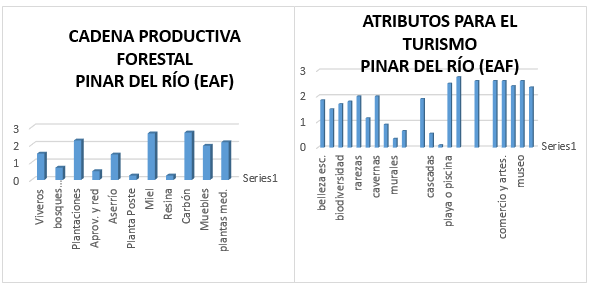
Fig. 8 - Elements of the forest production chain and landscape attributes in Pinar del Río Agroforestry Enterprice (EAF)
In Pinar del Río, although to a lesser extent than Macurijes, La Palma, Minas and Guanahacabibes, both elements can be appreciated, in addition to the fact that it is a provincial capital with greater facilities for tourism logistics in terms of lodging, transportation, commerce, among others (Figure 8).
Summarizing what was stated by those surveyed, the results were as follows:
As could be seen, one of the sites with the greatest integrality in terms of elements of the productive chain and landscape attributes that can be appreciated by tourists, was Macurijes, followed by La Palma, Minas de Matahambre and Guanahacabibes, so they should be priority destinations when designing route variants. Viñales could be included in secondary variants as could La Güira.
Methodological elements for route design
Name of the identification of the route. In this case: FORTUR forest-tourist route.
General data of the route.
General location and georeference.
Basic services.
The following are recognized as basic services: drinking water supply, availability of sanitary sewage, excreta disposal, public lighting, electric power distribution, and others.
By car to move from one attraction to another, while walking through the different productive sites, trails, cultural attractions, among others along the route.
The structure of the route includes the schedule of activities: duration, departure time, price, rate, minimum number of people.
Possible interactions with other existing routes and destinations.
Tourist attractions along the route.
Modalities of tourism on the route.
In addition to hiking, bird watching, landscape viewpoint, contemplation of flora and fauna diversity, as well as other tourism modalities, everything related to the particularities of forestry production and guided visits to the different links in the forestry production chain with trained personnel are included.
Visitor profile: people interested in interacting with nature and learning about forests and their presence in the landscape.
Tourist services.
Tourist safety.
If there are public health services, hospitals, medical clinics and national police units, other national police services.
Image of the route layout.
Itinerary of the route mounted in GIS with variants.
Plan de marketing
In order to prepare the marketing plan, the following will be taken into account:
Situation analysis (surveys and interviews).
Preparation of SWOT matrix.
Elaboration of internal factors (EFI) and external factors (EFE) matrices.
High impact matrix and strategies for the route according to matrix analysis.
Marketing Mix strategies, taking into account: product, price, place. Promotion: advertising, billboard, destination information billboard, cultural attractiveness pictogram, approach signs, public relations and media.
Marketing plan budget.
CONCLUSIONS
The respondents selected the sites with potential for the route, the most outstanding being Macurijes. The methodological elements for the design of the forest-tourist route were presented, with the necessary explanation for its understanding.
ANNEXES
Annexe1:
Survey
The main objective of this survey is to know criteria about the most representative sites in the forestry production chain in the province of Pinar del Río and their possibilities as tourist destinations, to be included in a forestry-tourism route. In advance we thank you for your participation and we seek the truthfulness in your answers that will be valuable contribution to this research.
General data:
Age ___ Sex ___
Schooling: Elementary ___ High School ___ Secondary ____ High School ___ Technical ___ Specialist ____ Professional ____
Institution where he/she belongs: MES _____ MINTUR ____ MINAG (Forestry Sector) ______
Occupation: _______________________________________________________
Regarding the questionnaire, respondents were asked to rate between 0 and 3, with 3 being the highest value, the following items:
Posibilidades para el turismo.
Representative forest production sites in Pinar del Río.
Chain links owned and quality.
Other considerations you may wish to add.
The sites presented are: Viñales, Macurijes, La Güira, Guanahacabibes, Minas de Matahambre, La Palma and the possibility is given to include another that they consider.
For the attributes of the forestry production chain, the following are presented:
Nurseries and/or germplasm (seedbeds) _____; natural forests ___; Plantations ___; Sustainable timber extraction and road network ___; Sawmill ___; Electric pole plant ___; Honey production __; Resin production ___; charcoal production ____; Furniture industry ___; Medicinal plant nursery___; Others Which?
Regarding the possibilities for tourism:
Scenic beauty ____; Trails within the forest ___; Biodiversity___; Endemism___; Rarities___; Archaeological elements ___ Which ones and value? caverns ____; petrifactions ___; Murals ___; Viewpoints___; Others _________________.
Hydrological elements: River___; waterfalls___; waterfalls___; waterfalls___; beach___; nautical tours___. Other Which ones? ___________________ ___________________;
Surrounding communities___; Cultural elements: Culinary ____; Commerce and handicrafts ____; popular culture activities___; Historical elements: Museum ___; Parks and statues___; Others. Which ones? ____________________ ____________________.
Thank you very much.
REFERENCIAS BIBLIOGRÁFICAS
ANDREU GUERRERO, R. y VERDÚ ALBERT, L., 2012. Turismo enológico en Alicante: la ruta del vino en el municipio de Pinoso. Cuadernos de Turismo [en línea], no. 30, pp. 35-61. [Consulta: 09/10/2020]. ISSN 1989-4635. Disponible en: Disponible en: https://revistas.um.es/turismo/article/view/160441 . [ Links ]
BLANCO, M. y RIVEROS, H., 2011. El agroturismo como diversificación de la actividad agropecuaria y agroindustrial. Estudios agrarios [en línea], vol. 17, no. 49, pp. 117-125. [Consulta: 10/03/2021]. ISSN 1405-2466. Disponible en: Disponible en: https://biblat.unam.mx/es/revista/estudios-agrarios/articulo/el-agroturismo-como-diversificacion-de-la-actividad-agropecuaria-y-agroindustrial . [ Links ]
CASTIÑEIRA, B. y JAVIER, C., 1998. La oferta turística complementaria en los destinos turísticos alicantinos/: implicaciones territoriales y opciones de diversificación. Publisher: Universidad de Alicante. Instituto Universitario de Geografía, Investigaciones Geográficas [en línea], no. 19. [Consulta: 09/10/2020]. ISSN 0213-4691. DOI 10.14198/INGEO1998.19.01. Disponible en: Disponible en: http://rua.ua.es/dspace/handle/10045/423 . [ Links ]
FERNÁNDEZ, G. y GUZMÁN RAMOS, A., 2003. El patrimonio industrial como recurso para organizar rutas turísticas. III Encuentro de Turismo Cultural. NAyA Buenos Aires, Argentina: Equipo NAYA, [en línea]. Disponible en: http://mail.arteprecolombino.com.ar/turismo_cultural/encuentro2003/ponencias/10%20Pat%20Ind%20Tandil.doc. [ Links ]
HERBERT, D., 2001. Literary places, tourism and the heritage experience. Annals of Tourism Research [en línea], vol. 28, no. 2, pp. 312-333. [Consulta: 10/03/2021]. ISSN 0160-7383. DOI 10.1016/S0160-7383(00)00048-7. Disponible en: Disponible en: https://www.sciencedirect.com/science/article/pii/S0160738300000487 . [ Links ]
OCHOA, I., PÉREZ, E. y HINOJOSA, E., 2012. VALORACIÓN DE UN PRODUCTO TURÍSTICO. Revista de investigación en turismo y desarrollo local (TURyDES) [en línea], vol. 5, no. 12. Disponible en: https://www.researchgate.net/publication/254411980_VALORACION_DE_UN_PRODUCTO_TURISTICO. [ Links ]
RITCHIE, J.R.B. y CROUCH, G.I., 2003. The Competitive Destination: A Sustainable Tourism Perspective [en línea]. S.l.: CABI. ISBN 978-0-85199-664-6. Disponible en: https://books.google.com.cu/books/about/The_Competitive_Destination.html?id=3UYpnwEACAAJ&redir_esc=y. [ Links ]
SAYADI, S. y CALATRAVA, J., 2001. AGROTURISMO Y DESARROLLO RURAL: SITUACION ACTUAL, POTENCIAL Y ESTRATEGIAS EN ZONAS DE MONTAÑA DEL SURESTE ESPAÑOL. Cuadernos de Turismo [en línea], no. 7, pp. 131-157. [Consulta: 10/03/ 2021]. ISSN 1989-4635. Disponible en: Disponible en: https://revistas.um.es/turismo/article/view/22091 . [ Links ]
URQUIOLA SÁNCHEZ, O. y LALANGUI, J., 2016. LA RUTA AGRO TURÍSTICA Y DE NATURALEZA BANAGUA DE LA PROVINCIA EL ORO. Revista Universidad y Sociedad [en línea], vol. 8, no. 3, pp. 128-134. [Consulta: 10/03/2021]. ISSN 2218-3620. Disponible en: Disponible en: http://scielo.sld.cu/scielo.php?script=sci_abstract&pid=S2218-36202016000300017&lng=es&nrm=iso&tlng=es . [ Links ]
Received: September 28, 2020; Accepted: January 25, 2021











 text in
text in 

